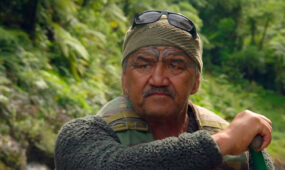Film review: The Australian Dream
Film & TV
Eloquently narrated by writer Stan Grant and featuring AFL star Adam Goodes revealing his story in his own words, The Australian Dream is a brilliant exploration of racism in this country.

The attacks on Goodes, an Adnyamathanha man, began after he responded to a racist taunt by a young girl during the annual Indigenous Round in 2013, with the backlash and booing intensifying after he was named Australian of the Year in 2014 and culminating in him leaving the game in 2015.
While another recent documentary about the saga, The Final Quarter, relied entirely on TV footage from the time, The Australian Dream – directed by Daniel Gordon – is a more comprehensive analysis of the treatment the champion AFL player received at the hands of football fans. It shows how it came close to destroying a man who was not only a champion footballer, but was also seeking to work towards true reconciliation.
Grant narrates and commentates throughout, and his perceptions are insightful and thought-provoking. The intelligent analysis is in stark contrast to the demonstrative ignorance of Sam Newman, now thankfully no longer being seen on television, and comments by Andrew Bolt, who chastises Goodes for dividing the nation on racial politics (despite the fact that obvious inequalities exist – and always have done – between Indigenous and non-Indigenous people).
While Goodes shares his story in his own words, the documentary also features players such as Gilbert McAdam and Nicky Winmar, who have both also suffered torrents of racial abuse from spectators. As Stan Grant points out – and Waleed Aly did, too, at the time – it is when Indigenous players speak out about racism and injustice that some football fans and media commentators suggest they have moved beyond their area of expertise and should not criticise Australian society.

Get InReview in your inbox – free each Saturday. Local arts and culture – covered.
Thanks for signing up to the InReview newsletter.
The Australian Dream is a film that needs to be seen by as many Australians as possible; it should be viewed in sporting clubs, schools and community centres to promote an ongoing discussion about the past treatment of Australian Indigenous people and ongoing issues such as reduced life expectancy, disproportionate incarceration rates, and inadequate housing and educational opportunities.
It is an emotional ride as viewers journey with Goodes and gain insight into his suffering and what he – and other Indigenous people – heard when the football crowds booed him, but hopefully it will engender understanding and empathy.
The Indigenous voices represented in this film are not playing race politics or attempting to divide Australia – they are seeking unity and reconciliation through truth and respect.
Support local arts journalism
Your support will help us continue the important work of InReview in publishing free professional journalism that celebrates, interrogates and amplifies arts and culture in South Australia.
Donate Here




